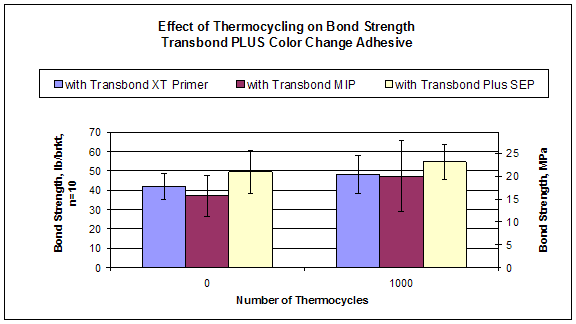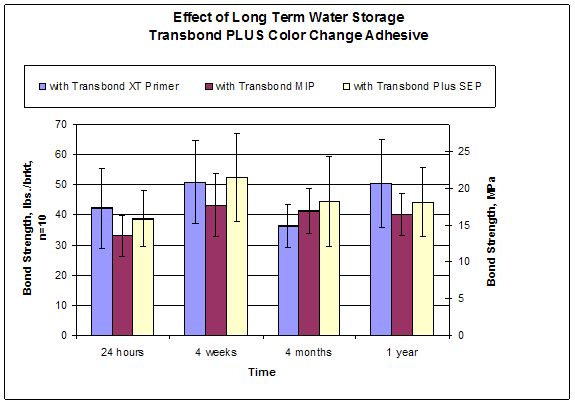ABSTRACT: 3112
Bond Durability of Transbond PLUS Color Change Adhesive
| S. TZOU, 3M Company, Monrovia, CA, USA | |
Orthodontic bonding adhesives must withstand thermally induced stress in the oral environment, and the bond must be durable throughout the treatment period. Objective: This study evaluates the effects of thermally induced stress (thermocycling) and long term water storage on the shear bond strength of Transbond PLUS Color Change Adhesive on bovine uncut enamel. Methods: Transbond PLUS Color Change Adhesive was tested for shear bond strength with Transbond XT Primer, Transbond MIP Moisture Insensitive Primer and Transbond Plus Self Etching Primer (all from 3M Unitek). The adhesive was pasted onto Victory Series upper central brackets (3M Unitek, REF 017-401) and bonded to bovine teeth, which had been pumiced, rinsed and etched/primed with one of the primers according to manufacturer's instructions. An Ortholux LED Curing Light (3M Unitek) was used to cure the brackets with a 5x5-second curing time. For the effect of thermocycling, bonded teeth were subjected 1000 cycles between 5șC and 55șC (30-sec cycles). For the effect of long term storage, bonded teeth were stored in 37șC water and tested for bond strength after 1 day, 4 weeks, 4 months and one year. Bond strength was tested in a shear-peel mode at a crosshead speed of 0.2 inch/minute using a MTS QTest/5 Universal Test Machine (MTS Systems Corporation). Bond strength was converted to MPa by dividing the force by the bracket base area. Results: mean bond strength ± standard deviation
Analysis of Variance showed that the bond strengths of this adhesive were not statistically different after thermocycling, nor were the bond strengths different between initial and one-year water storage, when used with all three primers. Conclusion: Transbond PLUS Color Change Adhesive retained good bond strengths on bovine uncut enamel after thermocycling for 1000 cycles as well as after one year stored in water, when used with all three primers.
| |
| Seq #290 - Orthodontics/Enamel Adhesion 1:45 PM-3:00 PM, Saturday, July 5, 2008 Metro Toronto Convention Centre Exhibit Hall D-E | |
|
Back to the Dental Materials 1: Adhesion - Bond Strength Testing and Mechanisms Program | |
©Copyright 2008 American Association for Dental Research. All Rights Reserved.

